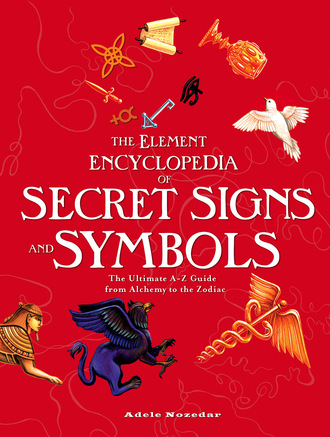
Полная версия
The Element Encyclopedia of Secret Signs and Symbols
When the Holy Communion of the Roman Catholic Church takes place, the simple ingredients of bread and wine are transformed, many believe, into the actual body and blood of the Christ. This is not just a symbolic representation, some say, but a very real and profound belief that underpins the foundations of the religion. By eating this holy, sacred food, imbued with magical intent, the recipient voluntarily absorbs the spirit of the Messiah.
The ritual and perceived reality of this act are inseparable, but bread and wine are not the only sacred foods we absorb as part of our everyday lives. We need food to live, so it comes as no surprise that we have accorded many ingredients with magical powers. Indeed, some of the things we eat every day carry both constituent elements and meanings which go far beyond mere nutrition. Many other foods—nuts, apples, and other fruits and vegetables—are covered in other sections of this book, and this is by no means an exhaustive inventory, but a look at some of the foods, real and mythical, which have become symbols in themselves.
AMBROSIA
For the Greeks, ambrosia was the food of the Gods. Given that it conferred immortality, the deities on Mount Olympus guarded it jealously. As well as ensuring eternal life, ambrosia could be used as an ointment that could heal any wound. However, for a mortal, eating ambrosia was a big mistake. Take the story of Tantalus, for example. He was invited to eat with the Gods, and so, presuming that he was accepted as one of them, he ate ambrosia. In the tradition of all good dinner party guests, he decided to return the favor and invited the Gods round to his place. Deciding somewhat sycophantically that they should feast upon all the good things that they had given him, he served up the flesh of his own children, and was banished to Hades.
CHOCOLATE
Long before the Western discovery of the Americas, the natives of Brazil, Mexico, the West Indies, and South America used the seeds of the chocolatl tree to make a stimulating drink. These bean-like seeds were cacahuatl, or cocoa. Primarily symbolic of love, chocolate is a sensual food with aphrodisiac properties that are due, in part, to association. However, its melting point is the same temperature as blood, a very satisfying sensation.
The botanical name of the plant gives a clue as to its sacred status. Theobroma cacao means “food of the Gods,” from the Greek “Theo,” meaning God and “Broma,” meaning food.
The beans were so highly valued that the Mayans used them as currency. Possibly the world’s first chocoholic, their ruler Montezuma was completely addicted to the beans. He drank them infused in cold water with no seasoning. He served this sacred drink in goblets of beaten gold, and at the coronation of Montezuma II in 1502 a concoction of chocolate and psilocybin mushrooms was served to the guests. This must have been a heady mixture.
Cortés cultivated the plant primarily because of its reputation as an aphrodisiac; this secret was divulged by one of the nineteen young women given to him by Montezuma as a tribute. Perhaps the 2000 chocolatl trees that he consequently planted were testimony to the efficacy of the beans in keeping the ladies satisfied.
By 1550, chocolate factories were operating in Lisbon, Genoa, Marseilles, and other European cities. The recipes became more and more refined. Catherine de Medici slowed down the progress of chocolate for a while because it was so good that she wanted it all to herself. However, although the Church tried to ban many of the foodstuffs that had been discovered in the New World, especially those that were considered as stimulants, their advice was largely ignored and it is possible that this disapproval increased the popularity of this illicit substance. Neither Catherine nor all the forces of the Church could stop the world becoming chocolate coated.
Today, the form of chocolate has changed so much that Montezuma would probably find it unrecognizable, both in taste and form. However, it is still unrivalled as a token and symbol of love.
HONEY
Legislation decrees that all packaged food carry a “best before” date, but this seems to be particularly unnecessary in the case of honey, since jars of the stuff found in the tombs of Egyptian kings of several thousand years ago has proved to be perfectly edible even now. It could well be because honey is so long lasting, and because it is used as a preservative, that it is a symbol of immortality and is used in funerary rites. The bees that make the honey have their place in the realms of magical creatures accorded with supernatural powers, but more of that in the Fauna section. The Promised Land is said to “flow with milk and honey” as being the very best that the Gods can offer.
The sweetness of honey is believed to confer gifts of learning and poetry. We’ll never know if the story that Pythagoras existed on honey alone is true, but the fact that the rumor exists is in accord with his God-like status. As well as being edible and fermentable, honey has healing and antiseptic qualities, and a dollop of honey smeared onto a wound will soon draw out any impurities and speed the healing process.
Honey is said to be an aphrodisiac and to encourage fertility and virility, wealth and abundance, and is a symbol of the Sun, partly because of the flowers from which it is made but also because of its color.
MANNA
When the Children of Israel were struggling to survive in the wilderness, manna appeared, miraculously, overnight, and so they could eat. Precisely what manna was—or is—is debatable. Some believe it might be a kind of fungus, others believe that it might be sap or resin exuded from the tamarisk tree. The symbolic meaning of manna is of something provided freely by the Universe or by God and is the ultimate reminder that we have everything we need. Manna is also associated with the Bread of Life or the Eucharist.
MEAD
Like honey, mead also carries the gift of immortality. The Celts believed it was the favored drink of the Gods in the Otherworld. Mead is a sacred drink in Africa, too, where it is believed that drinking the stuff will make you more knowledgeable. Worth a try! Mead is very simple to make—it’s simply honey mixed with water and allowed to ferment—and this process of fermentation is akin to a magical process in itself, which is akin to transmutation in alchemy.
MILK
Given that milk is the first food, it’s not surprising that it is associated with many stories of the Creation, and is a symbol of divinity. Amrita, or soma, the absolute nectar of life for Hindus and the equivalent of ambrosia, was created as a cosmic sea of milk was churned. The curds that were created by this epic stirring formed the Earth, the Universe, and the stars. Along with honey, there is an abundance of milk in the Promised Land, and Indian myths tell of a magical milk tree in Heaven. Because of its color and its association with the feminine, milk is a symbol of the Moon. The main food source for milk for us human beings (once we’re weaned) is the cow. The cow is sacred in India because during times of famine it made far more sense to keep the animal alive for its milk rather than slaughter and eat it purely for its meat, so all parts of the cow are accorded sacred status and are ruled over by one or other of the Gods or Goddesses.
In the hidden symbolic language of alchemy, the Philosopher’s Stone is sometimes called the Virgin’s Milk.
NECTAR
Nectar is often referred to as ambrosia, but has secrets of its own to tell. Flowers create it, and its scent attracts the bees, which then transform the nectar into honey. Seemingly insignificant, nectar is nevertheless a very magical ingredient, created from flowers, sunshine, and bees working together in a collective consciousness known as the “hive mind” in an environment which itself is constructed from one of the key shapes in sacred geometry, the hexagon.
SOMA
Like the Greek Olympians, the Indian deities had a type of food, like ambrosia, that ensured their immortality. This was soma, or amrita. Whereas dire consequences befell any mortal that dared to partake of ambrosia, the Indian Gods were more generous with their soma, and any mortal that ate it was immediately given immortality and access to Heaven. The ancient Indian Vedic scriptures, the Ramayana, tell the story of Rama, an epic hero, the perfect man. Rama was born after his father was visited by an angel. This angel brought with him some magical food. Eating this soma meant that Rama’s father was able to sire offspring that were the human incarnations of the God, Vishnu.
WINE
The symbolic meanings of wine are generally attached to the red variety; it seems that a nice dry white or a sweet rosé carries no hidden mystery. Here are some things to think about next time you open a nice bottle of claret.
The red color means that wine is often linked to blood, particularly since the wine is the “blood” of the grape. Because it looks like blood, wine is often used in rituals where blood would otherwise be called for, and because ceremonial wine is often drunk from a shared chalice, it is seen, like bread, as a unifying principle. Wine is male, and bread is female. As a partner to bread in the ritual of the Eucharist, the consecrated wine is transformed into the blood of the Christ, a reminder of both sacrifice and immortal life, and it’s this transformative power that accords wine with much of its mystique. When the water is turned into wine in the story of the Marriage at Cana, what is really being shown here is the transformation of the mundane into the magical, the Earthly into the Heavenly. It is this magical process of fermentation at work that explains why wine is associated with Bacchus/Dionysus, and the intoxicating power of wine is symbolic of divine possession.
The phrase, “In vino veritas” links wine to the truth and is a reminder that those intoxicated by perhaps a little too much of that nice claret will be more likely to speak the truth than most, which can be good or bad, depending on the circumstances.
GLOBUS CRUCIGER
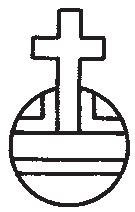
This is the globe surmounted by a cross, which is one of the Christian symbols of authority, and its symbolism is obvious. The orb represents the Earth, and the Cross, that major symbol of the faith, is Christ’s supremacy over it.
The Globus Cruciger is often depicted as an actual object but was also used purely as a symbol on Roman coins from the time when Christianity became the prominent religion, round about the fifth century AD. Prior to this, the lone orb had been used in the same way, to imply authority. The addition of the cross brought the well-known emblem into the Christian domain. In Britain, the Globus Cruciger appears as a physical object that is used during the coronation of the monarch. It is called the Orb and is part of the Royal Jewels.
GOAT OF MENDES
Also called the Sigil of Baphomet or the Sabbatic Goat, this sinister-looking symbol features an inverted pentagram containing the head of a goat, the upward V of the star framing the horns. This symbol has become an icon of modern occultism, believed to be the very representation of the Devil himself, which was exacerbated when Anton La Vey adopted it in the 1960s for his Church of Satan.
Sometimes the symbol is encircled with a double ring, containing the Hebrew letters spelling “Leviathan,” the mythical sea monster that features in the Old Testament.
GOPURA
The ornately elaborate gateway into the Hindu temples, the Gopura carry the same significance as the Japanese Torii, marking a transition between the world of matter and the world of spirit.
GRAY WOLF
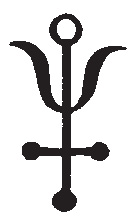
Otherwise known as Lupus Mettalorum, in alchemy antimony is disguised as the gray wolf. This gray wolf is the penultimate stage in the making of the Philosopher’s Stone, so in terms of the spiritual and psychological development of man it symbolizes the condition that brings him very close to the enlightenment he seeks; however, both physically and metaphorically speaking, the final stage of making lead into gold is yet to come, so the gray wolf can symbolize either success or failure.
GREAT SEAL OF THE UNITED STATES OF AMERICA
See United States dollar bill.
GREEN MAN
The symbol of the Green Man could be said to lurk in the subconscious minds of anyone with an affinity for leafy, wooded, and bosky places, although the term was not coined in the UK until the 1930s. Such a character—latterly interpreted as being the raw spirit of Nature—exists not only in the British Isles but in India, Asia, and Arabic countries too.
With a head seemingly constructed of leaves and vines, the Green Man is sometimes depicted as human, and sometimes as an animal. Despite his popularity as a garden ornament and its proliferation in garden centers, one of the oldest Green Man symbols discovered thus far is a piece of stonework on an Irish obelisk that dates back to 300 BC. Irish myth features a character called a Derg Corra, meaning “man in the tree,” and it may well be the case that he and the Green Man are one and the same. See Part 5, “Sacred Geometry and Places of Pilgrimage,” for an example of the Green Man made into a living maze.
SIGNS AND SYMBOLS OF FREEMASONRY
Although many of the entries in this encyclopedia have an association with Freemasonry, many secret signs and sacred symbols belong specifically to this discipline, hence the need for a separate entry dedicated to the Craft.
The Catholic Encyclopedia describes Freemasonry as
a system of morality veiled in allegory and illustrated with symbols.
Many of the signs and symbols associated with this ancient brotherhood are necessarily to do with building and architecture, and the instruments of these disciplines are used to carry analogies. One of the central tenets of Freemasonry, however, is that there should be as little dogma as possible, and so the meanings of many of the associated symbols are deliberately oblique and can remain open to personal interpretation.
1. ACACIA
Represents the idea of initiation, and is also used in Masonic funerals as a symbol of rebirth. The martyred master mason who designed the Temple of Solomon at Jerusalem, Hiram Abiff, had his burial place marked with an acacia branch. See Acacia in Part 4.
2. BLAZING STAR
Freemasons give this name to the Pentagram. Freemasons, like Pythagoras, regard the number 5 as sacred.
3. COLUMN
Many of the symbols within Freemasonry take their inspiration from the Temple of Solomon, the first temple in Jerusalem.
The structure of the Masonic Hall generally has two columns at either side of its main door that relate to the original columns set by the architect, Hiram, in the porch of the temple. These original columns were made of brass or bronze. The pillars are known by their Hebrew names and are also referred to in the Kabbalah; on the right is Jachin (meaning stability) and the left is Boaz (meaning strength). The columns also have a male/female polarity, Jachin often painted red to symbolize the Sun and fiery qualities of the active male principle, and the female Boaz painted white for the Moon and the passive feminine virtues. In rites, the columns are used to denote the grade of mason. Apprentices stand before the red column, Masons stand in front of the white column, and the Master Masons in the central space between the two.
4. COMPASSES
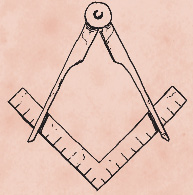
One of the foremost symbols within Freemasonry, the compasses combine with the Masons’ Square. The letter G might be incorporated into the design, especially in older representations, and other elements might be added; a Sun and Moon, for example.
Although Freemasons prefer to leave many of their associated symbols open to interpretation, we can make some assumptions about this particular emblem simply by looking at its form and by bearing in mind how the tools are used.
Both the compass and the square are mathematical tools, used for precise measurements in disciplines that can leave no room for error: building, construction, and architecture. There is a natural symbiosis between these tools, since the circle is used to form the square, and the square can be used to give form to the circle; this is called squaring the circle and is a fundamental rule applied to geometry, sacred or otherwise. Any instruments used for measuring must, ergo, be symbols of judgement and definition.
Further, in this Masonic pairing, the feminine circle (which it is the sacred task of the compasses to create) forms a perfect union with the masculine square; therefore the spiritual combines with the material, Earth with Heaven. Another aspect of the compasses and the square delves even further into the symbolism of the circle and the square, with the former representing space and the latter, time. The mason, as “architect,” rules over all these aspects and dimensions.
Because they are used to draw a perfect circle, the compasses themselves have significance as a tool used by God as the “architect” of the Universe. This idea is represented perfectly in the William Blake painting The Ancient of Days Measuring Time in which God stretches toward Earth, compasses in hand, with the golden disc of the Sun behind him.
Compasses work by turning on a central axle or pivot. This means that they are also a symbol of the Axis Mundi, of the circular nature of time, and of the ouroboros, the serpent which continually swallows its own tail.
4a. THE SQUARE
There’s a common phrase, “on the square” or “on the level.” This means to be open, honest, proper, and above board, and springs directly from Masonic practice and ritual.
All the symbolism of the square and of the number 4 is applicable to this tool; it stands for solidity, respect, security.
4b. THE ANGLE OF THE COMPASS
Accounts differ as to whether the angle of the compass carries any special significance. The Masonic Compass is certainly drawn in different degrees. Some say that this represents the different degrees within Masonry, but again this is a matter for the inner sanctum of Masons.
4c. THE TRIANGLE
Both the square and the compasses form a triangle, a symbol both of stability and of the spirit world.
4d. THE SIX-POINTED STAR
Hidden within the square and compasses symbol is another magical sign, the Seal of Solomon, the hexagram or six-pointed star. This can be made if a line is drawn across the open point of the square and compasses. The seal is formed of two interlocking triangles and is one of the most ancient and universal magical symbols, also used in alchemy. Among other meanings, this star can be interpreted to mean “as above, so below.”
4e. THE LETTER G
This does not always feature in the symbol of the compass and the square, and when it does there is ambivalence as to its meaning. Some say that it stands for God, others argue Geometry. Other interpretations including the notion that the G stands for Generation or possibly Government or even the Great Bear, the star that signifies the celestial pole or center, not only a physical center but a philosophical one. However, Masons agree that there is no definitive answer.
5. HIRAM ABIFF
The legend of Hiram Abiff is the central core and inspiration for Freemasons. Hiram was a Master Mason who specialized in metalwork, and was one of the prime designers of the Temple of Solomon in Jerusalem. Here is the legend.
After the temple was completed, three of the other workers decided that they wanted to extract the secrets from Hiram that would qualify them to be Master Masons. They positioned themselves at the doors of the temple and individually demanded to know these secrets. Hiram refused each one in turn, telling them that the knowledge they desired could be gained only by experience. The three turned on Hiram and killed him; one struck a blow to his throat with a rule, the next hit him on the chest with an iron measuring square, and the third finished the job by hitting him on the forehead with a hammer. Full of remorse for the crime that they quickly realized was a fruitless murder, the “three ruffians,” as they came to be called, buried Hiram and placed an acacia tree over his grave.
However, although Hiram was effectively dead, his memory lives on and so effectively he is reborn. The initiation of the grade of Master Mason re-enacts the ritual of the death of Hiram. In as much as there are any hard and fast rules which apply to the symbolism inherent within Freemasonry, the three blows symbolize three different kinds of death: the death of the body (the blow to the throat), the death of the feelings (the strike on the chest), and the death of the mind (the blow to the forehead). Thus, the would-be Master Mason leaves his old self behind, the initiatory process symbolizing his rebirth into the higher moral values that were held by Hiram, of integrity, knowledge, and detachment. In other words, the mason is reborn as a better individual, having risen above the ignorance, hypocrisy, and envy personalized by his murderers.
6. HAMMER AND CHISEL
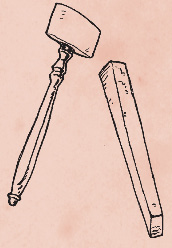
The hammer, in use at Masonic meetings, is not used simply to gain the attention of the gathering. Effectively, it represents the powers of the intellect that drive the thoughts and the will of the individual. At Lodge meetings, the hammer is the symbol of the authority of the Worshipful Master who presides over the meeting.
The chisel is only useful if it is directed by the will of the hammer, and so represents the intellect and finer discernment.
7. LEVEL AND PLUMBLINE
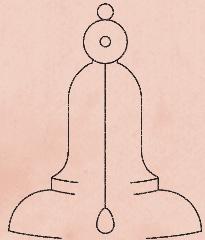
Again, the level and the plumbline attached to it are inseparable items of practical building equipment that serve a deeper symbolic meaning within Freemasonry. The level comprises a set square, from the center of which hangs the plumbline. The plumbline is used to define both the vertical and horizontal lines, so it takes on the symbolism of the cross, too. The vertical level symbolizes the apprentice, and the horizontal, the degree of Fellowcraft.

